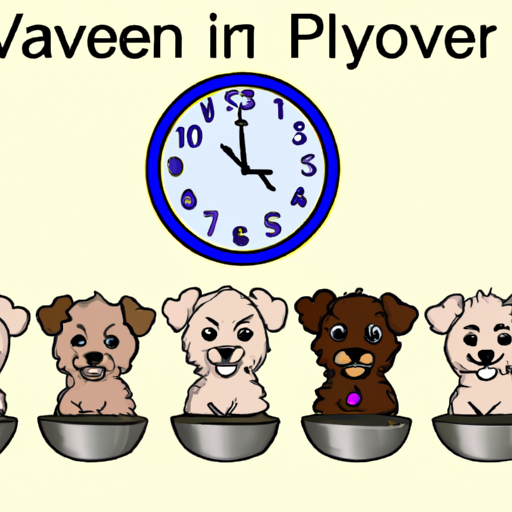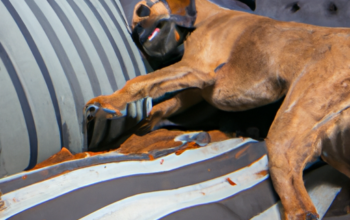Just as the saying goes, ‘You are what you eat,’ this truth is no different for your furry friend. Understanding how much to feed your puppy each day can feel like navigating through a maze of nutritional needs, breed specifications, and activity levels.
This article aims to guide you along that path with detailed information about portion sizes according to age and breed, understanding the impact of your pup’s energy level on their dietary requirements, and teaching you how to recognize healthy eating habits in dogs.
By equipping yourself with this knowledge, not only will you be serving your pet’s best interests but also ensuring their overall well-being and longevity. Let’s embark on this journey together to ensure our puppies are getting the right food quantities they need each day for optimal growth and health.
Understanding Nutritional Needs of Young Dogs
Imagine you’re a chef, carefully crafting meals for your furry little friend. You need to understand that your pup’s nutritional needs are unique and different from yours, and it’s crucial to ensure they get the right balance of proteins, carbs, fats, vitamins, and minerals every day.
As their caregiver, it’s your responsibility to provide them with all essential nutrients required for their growth and development. Puppies need more calories per pound than adult dogs because they’re growing rapidly. The proportion of these nutrients can vary depending on their breed size too!
So, always remember to consult with a veterinarian or pet nutrition expert before deciding on the quantity and type of food for your young canine companion.
Importance of Dog Breed and Size
It’s critical to remember that a diminutive Chihuahua isn’t going to devour the same amount as a towering Great Dane; their breed and size dictate the quantity of food they’ll need. Breed-specific nutritional needs are essential considerations in determining your puppy’s diet.
-
Small breeds generally require more calories per pound compared to larger breeds because of their higher metabolic rates.
-
Larger dogs tend to grow slower, thus requiring balanced nutrients over an extended period.
-
Certain breeds may have unique dietary requirements due to specific health issues prevalent among them.
Understanding these aspects ensures you provide your pooch with the right nutrition for healthy growth and development. As someone who desires serving others, take this knowledge into account when advising about proper puppy feeding practices.
Adjusting Portion Sizes Based on Age
As your tiny furball grows into a full-fledged canine, you’ll need to tweak the portions on their dinner plate accordingly. Age plays a crucial role in determining your pet’s dietary needs.
Below is a general guideline for adjusting your dog’s food intake based on age:
| Age of Puppy | Small Breeds (cups/day) | Medium Breeds (cups/day) | Large Breeds (cups/day) |
|---|---|---|---|
| 2-3 months | 1/4 – 1 | 1/2 – 1 | 3/4 – 2 |
| 4-5 months | 1/2 – 1.5 | 1 – 2 | 2 – 4 |
| 6-12 months | 1/2 – 1.75 | 2 – 3.5 | 4 – 6 |
Remember, each pup is unique and these are just rough estimates. Always consult with your vet to establish the most suitable diet plan for your growing companion.
Considering Activity Level
Just picture your furry friend bouncing around the park, their tail wagging vigorously with each bound; that high level of energy requires a hearty diet to keep them going strong.
The amount of food needed by your pup varies based on how active they are daily. Active puppies who spend lots of time playing, running, or training may need additional fuel in comparison to their less active counterparts.
Remember, the quality of food you’re providing plays an essential role too. Foods rich in protein and healthy fats will provide sustained energy for all those playtimes. It’s also wise to consult your vet about any dietary adjustments based on activity level as overfeeding can lead to obesity and other health issues.
Always aim for balanced nutrition suitable for your puppy’s lifestyle.
Recognizing Signs of Healthy Eating Habits in Dogs
Monitoring your dog’s eating habits can provide valuable insights into their overall health and wellbeing. Recognizing signs of healthy eating in your puppy is the first step towards ensuring they grow up strong and healthy.
Here’s a simple table to help you understand some key indicators:
| Signs of Healthy Eating | What It Means |
|---|---|
| Consistent appetite | Your puppy eats regularly, showing interest in food without overeating. |
| Good weight | Based on breed and age, your puppy maintains an appropriate weight. |
| High energy level | Your puppy is active, playful, and responsive after meals. |
Remember, each dog is unique and these guidelines may not apply universally. If you notice any concerning changes in your pup’s eating habits or behavior post-meal, it’s best to consult with a veterinarian for professional advice.
Frequently Asked Questions
What types of food are harmful to puppies and should be avoided?
Like a child reaching for the cookie jar, puppies may crave foods they shouldn’t have. Avoid feeding them chocolate, caffeine, grapes, onions, garlic, and alcohol. These can cause serious health issues or even death.
Is it okay to feed a puppy human food and what types of human food are safe for puppies?
Feeding a puppy human food isn’t generally recommended. However, some foods like cooked chicken, rice, pumpkin, and carrots are safe. Always avoid chocolate, onions, grapes/raisins, caffeine and alcohol as they’re toxic to dogs.
How often should a puppy be fed in a single day?
Like clockwork, a puppy’s feeding schedule should be consistent. Generally, puppies should be fed three to four times a day. This routine helps regulate their digestion and keeps their energy levels steady throughout the day.
Can a puppy’s eating habits change as it grows and how can I adapt to these changes?
Yes, a puppy’s eating habits can change as they grow. Monitor their appetite and weight closely. Changes may require adjusting meal sizes or frequency. Consult your vet for personalized advice on adapting to these changes.
How can I prevent my puppy from being a picky eater?
To prevent your puppy from becoming a picky eater, introduce a variety of healthy foods early on. Keep a consistent feeding schedule and avoid offering table scraps or changing diets frequently. Be patient and persistent.
Conclusion
Don’t fret if your pup’s eating habits don’t align perfectly with guidelines. Every dog is unique in its needs and preferences. What’s crucial is monitoring their health, energy levels, and growth. If they’re thriving and the vet gives a thumbs up, you’re on track!
Remember, your pup’s well-being hinges on balanced nutrition – so keep experimenting until you find what works best for them.



